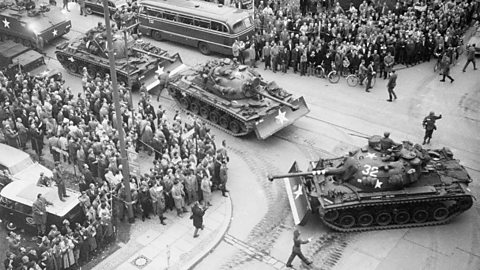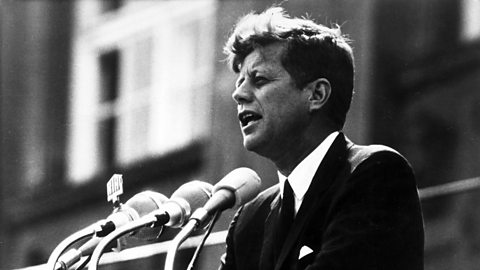The US response to the Berlin Wall
Alarmed by the building of the Wall, President Kennedy sent his Vice-President, Lyndon Baines Johnson, and US General Clay to Berlin. He also dispatched the US First Battle Group to reinforce the Allied soldiers in West Berlin. Spread along nearly 100 miles of road, the US military crossed East German territory and paraded into Berlin in an obvious show of military strength.
Stand-off at Checkpoint Charlie

Once the wall was up, the US decided to test how far they could push the USSRUnion of Soviet Socialist Republics - collection of states, also known as the Soviet Union.. Foreigners were still allowed to cross the Wall, and the US regularly sent troops and diplomats into the Soviet sector through Checkpoint CharlieThe main crossing point in the Berlin Wall between the East and West Berlin. There was a standoff between American and Soviet tanks here when the wall was first built in 1961., one of the guarded crossing points between East and West. Both sides were entitled to do this under the Four Powers Agreement made after the Yalta ConferenceA meeting of Churchill, Stalin and Roosevelt in 1945, where they planned the warās end, the division of Germany into occupation zones and how post-war Europe should be organised. .
On 27 October 1961 the Soviets blocked an American diplomat crossing to the East. The USA reacted and brought tanks up to Checkpoint Charlie, to reaffirm their rights to cross. The Soviets responded by bringing their own tanks up to the border. All day long the two sides, with tanks and soldiers at the ready, faced each other in a tense stand-off. The nail-biting crisis lasted for 18 hours until diplomatic negotiations meant that both sides began slowly to withdraw.
President Kennedy visits Berlin

On 26 June 1963, US President John F Kennedy visited Berlin and made a famous speech in which he claimed that Berlin was a symbol of freedom and the struggle against communismA classless society where all property is owned publicly.. It was a strong, defiant message and put an end to Soviet hopes of driving the Allies out of Berlin.
During his famous speech Kennedy declared āIch bin ein Berlinerā (a phrase intended to mean āI am a citizen of Berlinā). His intention was to show that he was standing alongside the people of Berlin in their struggle against communism. Unfortunately a 'Berliner' is also a type of German jam doughnut and so many misinterpreted the statement and claimed that Kennedy said āI am a jam doughnutā!
The Berlin Wall remained a symbol of Cold War tension until it was torn down in November 1989.
"Ich bin ein Berliner" speech